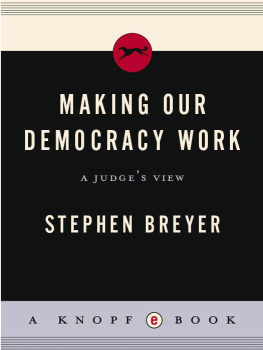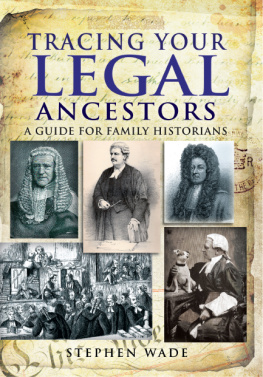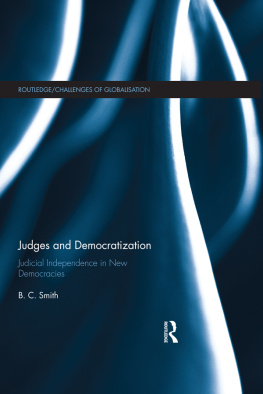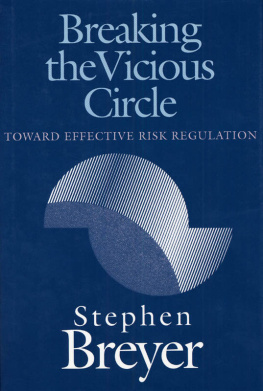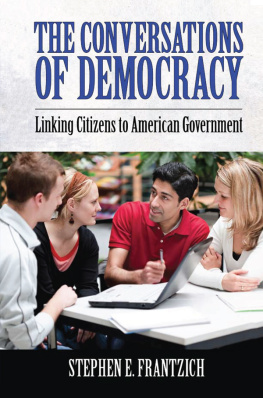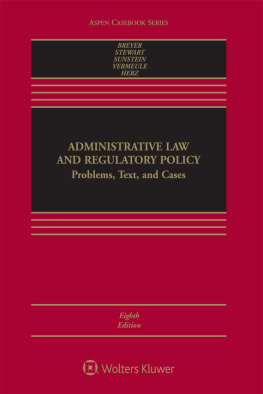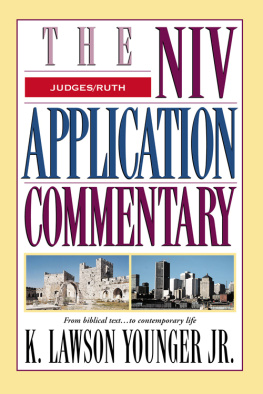Stephen Breyer - Making Our Democracy Work: A Judges View
Here you can read online Stephen Breyer - Making Our Democracy Work: A Judges View full text of the book (entire story) in english for free. Download pdf and epub, get meaning, cover and reviews about this ebook. year: 2010, publisher: Knopf, genre: Politics. Description of the work, (preface) as well as reviews are available. Best literature library LitArk.com created for fans of good reading and offers a wide selection of genres:
Romance novel
Science fiction
Adventure
Detective
Science
History
Home and family
Prose
Art
Politics
Computer
Non-fiction
Religion
Business
Children
Humor
Choose a favorite category and find really read worthwhile books. Enjoy immersion in the world of imagination, feel the emotions of the characters or learn something new for yourself, make an fascinating discovery.
- Book:Making Our Democracy Work: A Judges View
- Author:
- Publisher:Knopf
- Genre:
- Year:2010
- Rating:5 / 5
- Favourites:Add to favourites
- Your mark:
- 100
- 1
- 2
- 3
- 4
- 5
Making Our Democracy Work: A Judges View: summary, description and annotation
We offer to read an annotation, description, summary or preface (depends on what the author of the book "Making Our Democracy Work: A Judges View" wrote himself). If you haven't found the necessary information about the book — write in the comments, we will try to find it.
Making Our Democracy Work: A Judges View — read online for free the complete book (whole text) full work
Below is the text of the book, divided by pages. System saving the place of the last page read, allows you to conveniently read the book "Making Our Democracy Work: A Judges View" online for free, without having to search again every time where you left off. Put a bookmark, and you can go to the page where you finished reading at any time.
Font size:
Interval:
Bookmark:
ALSO BY STEPHEN BREYER
Active Liberty
Breaking the Vicious Circle
Regulation and its Reform

THIS IS A BORZOI BOOK
PUBLISHED BY ALFRED A. KNOPF
Copyright 2010 by Stephen Breyer
All rights reserved. Published in the United States by Alfred A. Knopf, a division of Random House, Inc., New York, and in Canada by Random House of Canada Limited, Toronto.
www.aaknopf.com
Knopf, Borzoi Books, and the colophon are registered trademarks of Random House, Inc.
A portion of this work previously appeared in The New York Review of Books.
Library of Congress Cataloging-in-Publication Data
Breyer, Stephen G., [date]
Making our democracy work : a judges view / by Stephen Breyer.
p. cm.
eISBN: 978-0-307-59426-6
1. Judicial reviewUnited States. 2. Judicial reviewUnited States History. 3. Political questions and judicial powerUnited States. 4. Separation of powersUnited States. I. Title.
KF4575.B73 2010
347.7312dc22 2010016839
v3.1_r1
To my grandchildren
Clara, Ansel,
Eli, Samuel,
and Angela
M Y OBJECTIVE IN WRITING THIS BOOK IS TO INCREASE THE publics general understanding of what the Supreme Court does. The Constitutions framers and history itself have made the Court the ultimate arbiter of the Constitutions meaning as well as the source of answers to a multitude of questions about how this vast, complex country will be governed, and thus it is important that the public understands how the Court carries out its role. I try to facilitate that understanding by explaining how the Court first decided that it had the power to hold a federal law unconstitutional, by showing how and why it was long a matter of touch and go whether the public would implement the Courts decisions, and by explaining how, in my view, the Court can, and should, help make the Constitution, and the law itself, work well for contemporary Americans.
This book is the work of a judge, a member of the Court, and it essentially contains my own reflections about the Court and the law. When I read a case, including those decided long ago, I can try to imagine how its author might have felt or reasoned, but I cannot speak as a historian, a political scientist, or a sociologist. Thus, my historical descriptions rely on only a few, but well-accepted, historical sources.
Because I believe it important for those who are not lawyers to understand what the Court does and how it works, I have tried to make the book accessible to a general audience. A few chapters involve more complicated and technical matters, but there too I have tried to make the discussion accessible even to a non-lawyer who can grasp the general themes without following every detail. And, in discussing cases, I have often simplified considerably, abstracting from the many factors that enter a judges decision-making calculus, to highlight a few factors that I believe are key. I hope some readers will want to understand the cases more fully and read the cases themselves. They are easily obtainable on the Supreme Courts Web site, . I hope this book manages to be both interesting and informative to members of the public, lawyers and non-lawyers alike.
D AY AFTER DAY I SEE A MERICANSOF EVERY RACE, RELI gion, nationality, and point of viewtrying to resolve their differences in the courtroom. It has not always been so. In earlier times, both here and abroad, individuals and communities settled their differences not in courtrooms under law but on the streets with violence. We Americans treasure the customs and institutions that have helped us find the better way. And we not only hope but also believe that in the future we will continue to resolve disputes under law, just as surely as we will continue to hold elections for president and Congress. Our beliefs reflect the strength of our Constitution and the institutions it has created.
The Constitutions form and language have helped it endure. The document is shortseven articles and twenty-seven amendments. It focuses primarily on our governments structure. Its provisions form a simple coherent whole, permitting readers without technical knowledge to understand the document and the government it creates. And it traces the governments authority directly to a single source of legitimizing powerWe the People.
Words on paper, however, no matter how wise, are not sufficient to preserve a nation. Benjamin Franklin made this point when, in 1787, he told a Philadelphia questioner that the Constitutional Convention had created a republic, Madam, if you can keep it. The separate institutions that the Constitution fashionedCongress, the executive, the judiciarywere intended to bring about a form of government that would guarantee that democracy and liberty are not empty promises. But what would enable the Constitution to work not only in theory but also in practice? How could the nation make sure that the Constitutions limits are respected, that our citizens enjoy its important protections, that our legal system resolves disputes fairly and impartially, and that our courts dispense justice?
Alexander Hamilton, along with many of the other constitutional framers, thought that a Supreme Court would provide part of the answer. The Court would interpret the law, thereby enforcing the Constitutions limits. It would help ensure a democratic political system, and it would safeguard individual constitutional rights and liberties. Indeed, as the historian Gordon Wood has pointed out, by protecting the rights of minorities of all sorts against popular majorities, the Court would become a major instrument for both curbing [American] democracy and maintaining it.
In the framers eyes, then, the Court would help to maintain the workable democracy that the Constitution sought to create. I have previously written about the Court and democracy, explaining the ways in which that constitutional concept critically affects judicial interpretation of much of the Constitutions language and also how the Constitutions democratic objective assumes a public that actively participates in the nations political life. The present book focuses on the Supreme Courts role in maintaining a workable constitutional system of government. It discusses how the public and the Court can help make the Constitution work well in practice. And it shows why the Constitution necessarily assumes that the typical American learns something of our nations history and understands how our government works.
In particular, this book considers two sets of questions. The first concerns the publics willingness to accept the Courts decisions as legitimate. When the Court interprets the law, will the other branches of government follow those interpretations? Will the public do so? Will they implement even those Court decisions that they believe are wrong and that are highly unpopular? Many of us take for granted that the answer to these questions is yes, but this was not always the case. uses examples from our nations history to show how, after fragile beginnings, the Courts authority has grown. It describes how the Court was given the power to interpret the Constitution authoritatively, striking down congressional statutes that it finds in conflict with the Constitution. And it goes on to describe several instances where Supreme Court decisions were ignored or disobeyed, where the presidents or the publics acceptance of Court decisions was seriously in doubt. These examples of the Courts infirmityperhaps startling todaydemonstrate that public acceptance is not automatic and cannot be taken for granted. The Court itself must help maintain the publics trust in the Court, the publics confidence in the Constitution, and the publics commitment to the rule of law.
Font size:
Interval:
Bookmark:
Similar books «Making Our Democracy Work: A Judges View»
Look at similar books to Making Our Democracy Work: A Judges View. We have selected literature similar in name and meaning in the hope of providing readers with more options to find new, interesting, not yet read works.
Discussion, reviews of the book Making Our Democracy Work: A Judges View and just readers' own opinions. Leave your comments, write what you think about the work, its meaning or the main characters. Specify what exactly you liked and what you didn't like, and why you think so.

